People of the River: lost worlds of early Australia
Take a fascinating trip down Dyarubbin (the Hawkesbury-Nepean River) in the early colonial period with a trusty and observant guide.
READ REVIEW
↓
People of the River: lost worlds of early Australia
Grace Karskens | September 2020
I must admit to being a little underwhelmed when Grace Karskens first told me she was writing a book about the Castlereagh area on the Nepean River. I knew she would find an interesting history and tell it well, but after The Colony, her grand and rightly lauded account of Sydney’s early history, it seemed a bit peripheral. Since then I have played a small role on a couple of Karskens’s projects, giving me some tempting glimpses of the river. But even as I drew maps for the book, I didn’t grasp the bigger picture. Then I opened People of the River and it all became clear.
Dyarubbin (the Hawkesbury-Nepean River) is familiar not just to the many people who live along or near it. Most Sydneysiders and visitors have crossed it, without much thought, on the way to the Blue Mountains, to Canberra or to the Central Coast. By reading People of the River, people will learn why this forgotten farming society was so pivotal to the early Sydney colony, and why it remains important and relevant today. Karskens finds a highly engaging way to bring Dyarubbin – the river and its Aboriginal and immigrant communities – alive. She draws on past scholarship and meticulous new research, merging environmental, archaeological, historical, linguistic and Aboriginal perspectives. This allows her to switch effectively between the large scale and personal stories, which mean we never lose sight of the people on the ground.
The book contains 15 chapters spread across four parts (‘Deep Country’, ‘Frontiers’, ‘New Old Land’ and ‘People of the River’). ‘Deep Country’ introduce us to the long history of the river’s formation and reshaping. These are essential to understanding how and why people have lived along it. The history of Aboriginal occupation is astoundingly deep, containing some of the earliest dated evidence of human existence in eastern Australia. As an archaeologist, I am wary of how historians sometimes over-interpret and extrapolate this highly fragmented record, but Karskens manages to weave an engaging human story without moving beyond the limits of the evidence.
‘Frontiers’ richly illustrates the tentative, tenuous and violent history of the agricultural colonisation of parts of the river. By drilling into the historical record of the 1790s and early 1800s, Karskens picks up the ebb and flow of these early attempts. She shows how pessimistic assumptions of the failure of convict and ex-convict farmers made at the time, and by subsequent historians, do not match the reality. She also examines how these ventures were experienced by Aboriginal people, through both violent dispossession and cross-cultural interaction. By drawing together rarely combined perspectives, Karskens explains how and why Aboriginal people kept farmers out of the rocky reaches of the river in the 1790s.
‘New Old Land’ takes readers into the midst of the settler communities of the early nineteenth century. As Karskens writes, to understand how this world functioned, ‘we need to explore it from the inside’ (p. 221). Through settler vernacular and vivid description and illustration we can hear and sense this world as well as see it. By seeing how small farmers managed the ever-present risk of floods, and their prevailing views of access rights to commons, we come to better understand their lives and why they resisted larger land holders fencing and enclosing ‘their’ landscape.
The final section, ‘People of the River’, examines the personal lives of the farming communities, drawing revealing patterns of intermarriage and social relationships and the desire of successive generations to remain in the area. It also zooms out to describe the sacred landscapes of Aboriginal people, through a rich archaeological record and a priceless 1820s list of Aboriginal names along the river discovered by Karskens in the State Library of New South Wales. Karskens also describes government attempts to shatter Aboriginal connections through initiatives such as the Native Institution and the creative and culturally informed responses to such ‘civilising’ efforts from Aboriginal people. She introduces us to the fascinating Nellie Nah-Doongh, the so-called ‘last of her tribe’ and dispels any doubt that, more than a century after her death, the river continues to retain significance to Aboriginal descendants.
If these rich perspectives do not inspire readers to get out and explore the river, I don’t know what will.
Reviewer: Dr Paul Irish, PHA (NSW & ACT)
Grace Karskens is a Professor of History in the School of Humanities and Languages at the University of New South Wales. She is a long-time champion of public history through her award-winning writings and her advocacy through organisations such as Sydney Living Museums.
People of the River is published by Allen & Unwin.

